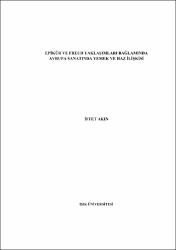| dc.contributor.advisor | Parkan, Uğur Mutlu | en_US |
| dc.contributor.author | Akın, İffet | en_US |
| dc.contributor.other | Işık Üniversitesi, Sosyal Bilimler Enstitüsü, Sanat Kuramı ve Eleştiri Yüksek Lisans Programı | en_US |
| dc.date.accessioned | 2016-06-07T06:32:59Z | |
| dc.date.available | 2016-06-07T06:32:59Z | |
| dc.date.issued | 2014-09-15 | |
| dc.identifier.citation | Akın, İ. (2014). Epikür ve freud yaklaşımları bağlamında avrupa sanatında yemek ve haz ilişkisi. İstanbul: Işık Üniversitesi Sosyal Bilimler Enstitüsü. | en_US |
| dc.identifier.uri | https://hdl.handle.net/11729/942 | |
| dc.description | Text in Turkish ; Abstract: Turkish and English | en_US |
| dc.description | Includes bibliographical references (leaves 155-162) | en_US |
| dc.description | xiv, 163 leaves | en_US |
| dc.description.abstract | İnsan varlığının, sürdürülebilme gereklerinden en ilkelidir yemek yeme eylemi. Yapılan araştırmalar, ilk insanların, önce topladıklarını, sonra avladıklarını yediğini ortaya koymuştur. Ateşle uygarlığın yolu adımlanmaya başlanmış, yeme eyleminden, yemek kavramına geçiş bu yolculuk esnasında gerçekleşmiştir. Yaşamın hızla devinen kültürel koşullarıyla, ticaret yollarında keşfedilen değişik besin maddeleri, ülkeler arası taşınmış, böylelikle de mutfaklar oluşmuştur. Bu çalışmada, yemeğin Avrupa’daki,sanatla yolculuğu, haz üzerinden incelenmektedir. Dinlerin ya da, toplumsal yapının belirlediği ritüeller, sektörel bir olguya dönüşmeden evvel ve sonra, Avrupa’da, halktan insanların masa başı sohbetlerinde, soyluların şaşaalı şölenlerinde nasıl yer aldı? Gıda maddeleri neden bir ressamın prestij imgesi oldu? Edebiyat metinleri, uzun yemekli betimlemeleri neden kendine konu seçti? Ya da bir sinema filminde, can alıcı sahneler, neden yemeğe dair aksesuarlarla sembolize edildi? Bu soruların cevabı, Epikür Hedonizmi ve Freud’un Haz İlkesi temel alınarak bulunmaya çalışılmıştır. | en_US |
| dc.description.abstract | Eating is the most savage need for human survival. The researches reveal that humans first ate what they gathered around then what they hunted. Fire ignited the civilization which paved the way to the consept of food from eating. humans first ate what they gathered around then what they hunted. Fire ignited the civilization which paved the way to the consept of food from eating. The changes and developments in the cultural conditions reshaped the usage newly encountered ingredients which resulted in the diversification of the culinary culture. This thesis examines the representations of food in European art and literatüre through the concept of pleasure. The rituals which were formed either by the religions or by the social structures transformed into phenomena. But before and after this transformation in what ways the rituals were represented during the table talks of the laymen as well as the feasts of the nobles of Europle? How and why foodstuffs become the prestigious image for painters? Why did the writers choose long descriptions of dinners and lunches? Or why did the directors choose the focus on the dinnertable accessories to symbolizeclimax points? This Theisis aimig to answer these and other questions on the basis of the concept of Epicurian hedonism and pleasure principle of Freud. | en_US |
| dc.description.tableofcontents | Giriş | en_US |
| dc.description.tableofcontents | Avrupa’da Tarihsel Süreç İçinde “Tat”ın Oluşumu, Devamında, Yeme- Yemek Ayrımının Ortaya Çıkışı ve Haz Duygusu | en_US |
| dc.description.tableofcontents | Hedonizmin Epikuros’la Buluşması ve Freud’un Haz Kavramının Epikuros’la Bağlantısı | en_US |
| dc.description.tableofcontents | Antikiteden Günümüze Yemeğin Hazla Bağlantısına, Avrupa Sanatından Örneklemeler | en_US |
| dc.description.tableofcontents | Avrupa Resminde Yemek Sahneleri | en_US |
| dc.description.tableofcontents | Avrupa Edebiyatında Yemeğin Ele Alınışı | en_US |
| dc.description.tableofcontents | Yemek ve Hazzın Sinemayla Buluşması | en_US |
| dc.description.tableofcontents | Sonuç | en_US |
| dc.language.iso | tur | en_US |
| dc.publisher | Işık Üniversitesi | en_US |
| dc.rights | info:eu-repo/semantics/openAccess | en_US |
| dc.rights | Attribution-NonCommercial-NoDerivs 3.0 United States | * |
| dc.rights.uri | http://creativecommons.org/licenses/by-nc-nd/3.0/us/ | * |
| dc.subject | Avrupa’da | en_US |
| dc.subject | Edebiyat | en_US |
| dc.subject | Epikür | en_US |
| dc.subject | Freud | en_US |
| dc.subject | Haz | en_US |
| dc.subject | Resim | en_US |
| dc.subject | Sinema | en_US |
| dc.subject | Epicuros | en_US |
| dc.subject | European cinema | en_US |
| dc.subject | European literature | en_US |
| dc.subject | European painting | en_US |
| dc.subject | Freud | en_US |
| dc.subject | Pleasure | en_US |
| dc.subject.lcc | N8217.F64 A35 2014 | |
| dc.subject.lcsh | Food in art. | en_US |
| dc.subject.lcsh | Epicurus. | en_US |
| dc.subject.lcsh | Painting -- Europe -- Criticism and interpretation. | en_US |
| dc.subject.lcsh | Hedonism. | en_US |
| dc.subject.lcsh | Motion pictures -- Europe. | en_US |
| dc.title | Epikür ve Freud yaklaşımları bağlamında Avrupa sanatında yemek ve haz ilişkisi | en_US |
| dc.title.alternative | Relation of food and pleasure in european art and literature through and Freudian approaches | en_US |
| dc.type | masterThesis | en_US |
| dc.contributor.department | Işık Üniversitesi, Sosyal Bilimler Enstitüsü, Sanat Kuramı ve Eleştiri Yüksek Lisans Programı | en_US |
| dc.relation.publicationcategory | Tez | en_US |
| dc.contributor.institutionauthor | Akın, İffet | en_US |



















